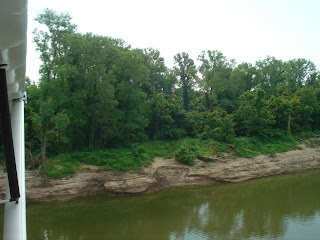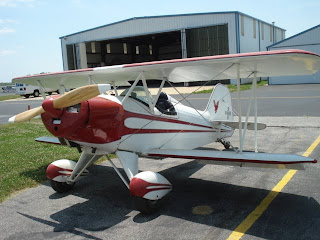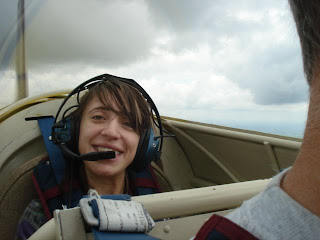
Continuing on, we flew in nice VFR weather. I called up Washington center for flight following, just to make sure I didn't stray into any of the restricted areas around Kitty Hawk. The controller suggested that I fly inbound on victor 189, an airway which avoids the restricted airspace. We had debated whether or not to fly into the First Flight airport, but decided not to since we would have to move the airplane after visiting the Wright Brothers memorial and museum. There is no fuel or security at this airport, although it would be neat to land at the site of the actual first flight of the Wright Flyer. The airstrip is about 100 yards from the now-famous site. We opted instead to land at MQI, Manteo airport. This is a full-service facility about ten miles south of Kitty Hawk. Nice and clean, and the fellow at the FBO there was very helpful suggesting good local restaurants.

We checked in and picked up our car, a Dodge Caliber. I'm confused about the mission of a vehicle such as this. It's smaller than a sedan, top heavy, ugly and slow. Maybe I'm just spoiled by my 330i, but I think this is the most anemic vehicle that I have ever driven. At any rate, it's good enough to plod around the outer bank as our vacation vehicle.
I have never visited this area before. I guess I should not have been surprised to find the beach ultra-developed. A good bit of it is pretty ugly, with strip malls and fast food places everywhere.
But I guess this is what you get where people come to vacation. Lots and lots of people. Fortunately, we arrived at the beginning of the off season, which starts in early October. I can imagine what it's like in the middle of the summer with throngs of people everywhere. The down side of the off season is that some of the things I wanted to do were not available. I wanted to rent a Hobie Cat sail boat, but they had just taken them out of the water and were not renting or running their school any more. The guy there was very nice, but he explained that they just didn't have the crowds to support the business. Guess you can't have everything.

Our hotel was the Hilton Garden Inn. Situated on the northern end of Kitty Hawk, this is a nice, new hotel. We sprung for the ocean view room on the 5th floor, which afforded us a spectacular view of the Atlantic Ocean.
The Hilton has a fishing pier for its guests. I didn't bring any fishing tackle, but that was easily remedied by a trip to a tackle shop just down the street from the hotel. I spent a few hours each day fishing off the pier. Using shrimp as bait, I reeled in a bunch of bluefish, spots and trout. I released everything I caught, so I didn't have to worry about cleaning fish. I met a lot of nice folks on the pier. I guess that's what happens when you fish on a pier. One fellow was there with his kid, and they watched me bring in a couple of fish using the shrimp. I donated a few shrimp to the kid and chatted with his dad. Turns out his name was Michael Cox. He tells me that he likes to hang out in Kitty Hawk and write. He writes horror novels, and he wrote a book called Souls Eternal, which is a vampire story. I went in and found it on Amazon.com. Neat!
 We spent the morning of the second day at the the Wright Brothers museum and memorial. This is a great treat for an aviation nut, especially a homebuilder. The park service has done a great job of preserving the land where the first flight was made. They have reconstructed the hangar and living quarters on the site, and a museum is there with small exhibits and a small bookstore. There are several daily half-hour lectures which detail how Orville and Wilber ended up coming here from Dayton, Ohio to fly gliders and ultimately a powered airplane on December 17, 1903.
We spent the morning of the second day at the the Wright Brothers museum and memorial. This is a great treat for an aviation nut, especially a homebuilder. The park service has done a great job of preserving the land where the first flight was made. They have reconstructed the hangar and living quarters on the site, and a museum is there with small exhibits and a small bookstore. There are several daily half-hour lectures which detail how Orville and Wilber ended up coming here from Dayton, Ohio to fly gliders and ultimately a powered airplane on December 17, 1903.I rented a bicycle and took a two hour cruise of the area on Thursday. North of Kitty Hawk is a town called Duck. Nicely developed with several good restaurants. There are a zillion homes built on the beach in this area and northward all the way to the Virginia border. They are all very upscale and in the range of 5,000 - 6,000 sq ft. It would be nice to rent one for the whole family (or two or three families).
There are plenty of restaurants, everything ranging from Hooter's and Outback to more expensive places. We got a tip from the guy at the bike shop (a former restaurant owner) and ended up a place called Colington's. It's in an old Victorian house. Nice atmosphere and great food.
Friday came all too quickly and it was time to go home. The weather was a bit more intimidating on the trip home with IFR conditions all the way to middle Tennessee. There was a frontal area extending across our path associated with a fair amount of level two and three precip showing on the Garmin 396's XM weather display. I filed IFR to Morgonton and we left at about 9:30. We were in the clouds most of the way, and checking the metar at our destination, I saw the little red flag on the Garmin. Weather was visability 1 mile, 100 ft ceiling in rain. I wasn't going to get in there on any of the three published approaches, so we changed our destination to Knoxville, which was considerably better. I was being vectored for the ILS approach, but I broke out of the clouds at about 2,500 ft AGL, and the controller gave me a visual approach to Rwy 5R. The place was pretty busy, and I realized it was the day before a Tennessee home football game. Still the lady at TAC Air (the nice, big FBO there) gave us a crew car so we could go get some lunch before continuing on to Memphis.

We were able to leave VFR, and we were back in the sunshine with a slight tailwind in about 20 miles. We were back on the ground at Dewitt Spain about two hours later, just under 5 hours of flying time total for the day.
We had a great time, and I would love to return to the outer banks of the North Carolina coast for a longer stay. Next time I'll do more fishing. I had forgotten how much I like fishing. When the RV-7 is finished, Mary and I will certainly put this area on the list of places to go.
MORE PICTURES
JC
10/18/08

















